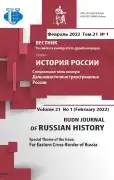Китайское население Забайкалья в условиях сталинской системы в 1930-е гг.
- Авторы: Дацышен В.Г.1,2,3
-
Учреждения:
- Институт демографических исследований Федерального научно-исследовательского социологического центра РАН
- Сибирский федеральный университет
- Красноярский государственный педагогический университет имени В.П. Астафьева
- Выпуск: Том 21, № 1 (2022): Дальневосточное трансграничье России
- Страницы: 57-71
- Раздел: ДАЛЬНЕВОСТОЧНОЕ ТРАНСГРАНИЧЬЕ РОССИИ
- URL: https://journal-vniispk.ru/2312-8674/article/view/322009
- DOI: https://doi.org/10.22363/2312-8674-2022-21-1-57-71
- ID: 322009
Цитировать
Аннотация
Статья посвящена проблемам истории китайского населения в приграничном с Китаем регионе Восточной Сибири в 30-х гг. ХХ в. Приграничный регион обусловил специфику формирования китайского населения, а возвращение в 1930-е гг. Забайкалья из Дальнего Востока в Сибирь усилило особенности развития китайской общины в регионе, нераспространение на нее «дальневосточной национальной политики». Особенности развития китайской общины в Забайкалье в 1930-х гг. были обусловлены полным закрытием государственной границы с Маньчжурией и появлением государственного образования Маньчжоу-Го, имевшего наряду с Китайской Республикой своих официальных представителей в Чите. В начале 1930-х гг. численность китайского населения в Забайкалье достигла максимума, и в Читинской области его доля по отношению к общему числу населения сравнялась с дальневосточными регионами. В 1930-х гг. условия труда и жизни большинства китайских рабочих были тяжелыми, они сталкивались с дискриминацией, слабо были адаптированы в социально-политические реалии «сталинской системы». Советские реалии 1930-х гг. обусловили активную политику большевиков в отношении китайцев, направленную на их идейно-политическое перевоспитание и улучшение условий жизни и работы. Во второй половине 1930-х гг. политика в отношении китайского населения изменилась, вопросы политико-просветительной работы и развития «советской китайской» культуры потеряли актуальность. Китайцы стали восприниматься как нелояльная советской власти национальная община, реальные или потенциальные агенты Японии и гоминьдановского Китая. С 1936 г. начались «разоблачения» китайских шпионов, а в 1937-1939 гг. советские китайцы, как одна из наименее защищенных от произвола советских спецслужб и карательных органов национальная община, сильно пострадали от политических репрессий. В конце 1930-х гг. численность китайцев в Забайкалье сократилась почти на треть, но здесь, в отличие от приграничных районов Дальнего Востока, их массового выселения не произошло.
Об авторах
Владимир Григорьевич Дацышен
Институт демографических исследований Федерального научно-исследовательского социологического центра РАН; Сибирский федеральный университет; Красноярский государственный педагогический университет имени В.П. Астафьева
Автор, ответственный за переписку.
Email: generalhistory2005@yandex.ru
ORCID iD: 0000-0001-6471-8327
р ист. наук, главный научный сотрудник Института демографических исследований Федерального научно-исследовательского социологического центра РАН; профессор кафедры истории России, мировых и региональных цивилизаций Сибирского федерального университета; профессор кафедры всеобщей истории Красноярского государственного педагогического университета имени В.П. Астафьева
119333, Россия, г. Москва, улица Фотиевой, д. 6, корп. 1; 660041, Россия, г. Красноярск, пр. Свободный, 82А; 660049, Россия, г. Красноярск, ул. Ады Лебедевой, дом 89Список литературы
- Fartusov, D.B. “Political Repression in Relation to Citizens of Mongolia and China in the Territory of BM ASSR.” BSU Bulletin. Human Research of Inner Asia, no. 1 (2015): 72-77 (in Russian)
- Lantsova, Yu.N. “Otnoshenie Sovetskoi vlasti k kitaitsam i koreitsam v Chitinskoi oblasti v dovoennyi period i vo vremia Velikoi Otechestvennoi voiny.” In Part 1 of Vtoraya mirovaya voina: predistoriya, sobytiya, uroki: materialy mezhdunar. nauch. konf. posvyashch. 70-letiiu Velikoi Pobedy nad nemetskim fashizmom i yaponskim militarizmom. 11-12 sentyabria 2015 g., 67-71. Chita: ZabGU, 2015 (in Russian)
- Motrevich, V.P. “Inostrannye grazhdane-kitaitsy v Sovetskom Soyuze po dannym Vsesoyuznoi perepisi naseleniya SSSR 1937 g.” In Kitai: istoriia i sovremennost': materialy VIII mezhdunarodnoi nauchno-prakticheskoi konferentsii. Ekaterinburg, 7-8 oktiabria 2014 g., 178-181. Yekaterinburg: Uralskogo un-ta Publ., 2015 (in Russian)
- Polyakov, Yu.A., ed. Vsesoyuznaya perepis' naseleniya 1939 goda: Osnovnye itogi. Moscow: Nauka Publ., 1992 (in Russian)
- Potapova, N.A. ‘Kharbinskaia’ operatsiia NKVD SSSR 1937-1938 gg.: mekhanizmy, tselevye gruppy i masshtaby repressii. St. Petersburg: Aleteiya Publ., 2020 (in Russian)
- Tarasov, A.P. Zabaikal'e i Kitai: opyt analiza mezhdunarodnykh svyazei. Chita: ZabGPU Publ., 2003. 432 s
- Vasilevskii, V.I. Tragicheskaшa stranitsa zabaikal'skoi istorii. 2 ed. Ulan-Ude: Domino Publ., 2012 (in Russian)
- Zalesskaya, O.V. Kitaiskie migranty na Dal'nem Vostoke Rossii (1917-1938 gg.). Vladivostok: Dal'nauka Publ., 2009 (in Russian)
- Zhiromskaya, B.B., and Polyakov, Yu.A., eds. Vsesoyuznaya perepis' naseleniya 1937 goda: Obshchie itogi. Sbornik dokumentov i materialov. Moscow: Rossiiskaya politicheskaya entsiklopediia Publ., 2007 (in Russian)
Дополнительные файлы









